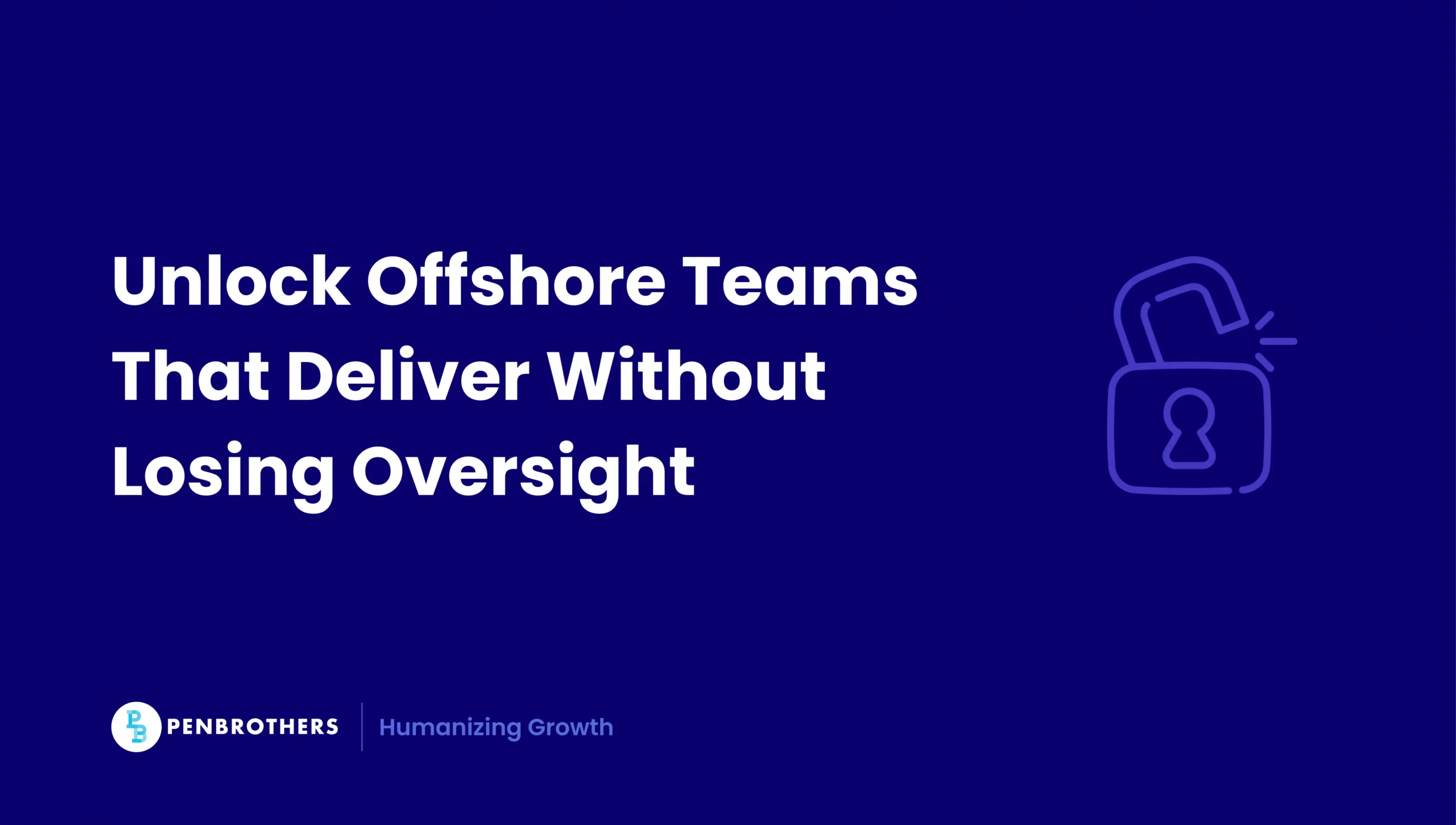What's Inside?
The 2025 UK Guide to Staff Augmentation for C-Level Leaders

You’ve had your senior developer position live for four months now. £220,000 all-in. The applications that trickle in are either wildly unqualified or from candidates who ghost you after the first interview. Meanwhile, your board wants faster product launches, your core team is burning out on overtime, and you’re competing for talent against Barclays and Deloitte.
The last time you tried offshore hiring, it fell apart within three months. Communication breakdowns, cultural friction, and a developer who just stopped showing up. The whole thing derailed your roadmap and cost you more than if you’d just kept limping along with your existing team.
But what most UK executives don’t realize is that the problem wasn’t offshore hiring itself. The problem was how it was done.
When staff augmentation is executed properly, it solves the exact problem you’re facing. You get expert capacity almost immediately, you cut costs by 60-70%, and you maintain complete control over your projects and processes. A clear path for IR35 compliance. No GDPR exposure you can’t manage. Just seamless integration that accelerates growth.
This guide explains how that actually works.
Key Takeaways
- A Strategic Tool to Combat UK Talent Shortages: IT staff augmentation is a strategic model for UK businesses to overcome severe domestic talent shortages and high local salaries. It provides immediate access to specialized, high-demand skills in areas like AI, cybersecurity, and DevOps that are otherwise unaffordable or unavailable.
- Maintains Full Control, Unlike Traditional Outsourcing: The key differentiator of staff augmentation is control. Unlike traditional outsourcing, where you hand over a project to a vendor, this model integrates external experts directly into your in-house team. They report to your managers and follow your workflows, giving you full operational oversight.
- Offshore EOR Model Solves Major UK Compliance Risks: This model provides a clear solution for two major UK compliance headaches. First, by contracting with an offshore Employer of Record (EOR) who legally employs the worker in their home country, the complex IR35 determination for contractors is completely bypassed. Second, a professional EOR manages UK GDPR compliance contractually, which is a significant risk when hiring individual freelancers.
- Structured Onboarding is the Key to Success: Most offshore failures are due to poor integration, not a lack of talent. A successful partnership depends on a structured onboarding process, like the 180-day “Hypercare Framework,” which systematically manages integration, performance alignment, and long-term retention, resulting in a much higher success rate (95%).
What Is Staff Augmentation?
Why the Textbook Definition Is Not Enough for UK Executives
The standard definition describes staff augmentation as an outsourcing strategy where you evaluate your current team, identify skill gaps, and bring in temporary contractors to fill them. In IT, it’s typically framed as hiring external professionals to supplement tech projects without long-term commitments.
For a UK C-level executive navigating post-Brexit talent shortages and regulatory complexity, this definition will not suffice. It evokes the exact thing you’re trying to avoid: relinquishing control. The word “outsourcing” carries the implication of abdication, which is precisely the opposite of what strategic staff augmentation actually delivers.
The Accurate Strategic Definition You Need
A more precise way to think about staff augmentation: it’s a strategic talent acquisition model that decouples the sourcing of specialized talent from the management of project execution.
Unlike full outsourcing, where you hand over an entire function to a vendor, staff augmentation lets external experts integrate seamlessly into your in-house team. They report directly to your management. They align with your workflows and timelines. You maintain complete control over projects.
It’s a high-level tool for surgically amplifying your core team’s capacity, exactly where you need it, without the overhead and risk of permanent hires.
Staff Augmentation vs Traditional Outsourcing
To clarify the distinction:
| Feature | Staff Augmentation (High-Control) | Traditional Outsourcing (Outcome-Based) |
| Primary Goal | Add skills and capacity to existing team | Deliver a complete, defined project |
| Client Control | High: Full oversight of tasks and staff | Low: Control over scope/deliverables only |
| Risk Profile | Low: Contained to individual performance | High: Risk of total project failure |
| Cost Structure | Variable (Time & Materials) | Fixed Price for defined scope |
| Best Use Case | Agile projects, filling skill gaps | Well-defined, non-core initiatives |
This framework shows why staff augmentation suits UK startups focused on agility and control.
What Is IT Staff Augmentation? The UK Tech Talent Lifeline
IT staff augmentation is the specialized variant, designed to bridge tech-specific gaps. It ranges from commodity-level support for routine tasks to skill-based hires for mid-tier roles like QA engineers, all the way up to highly-skilled experts for niche demands like AI or cybersecurity.
Essentially, you’re accessing specialists in artificial intelligence, blockchain, or complex architectures that are either scarce or prohibitively expensive domestically.
Real-World UK Use Cases (Cybersecurity, AI, DevOps)
A UK e-commerce firm augments its team with DevOps specialists to optimize cloud infrastructure. A fintech startup adds AI experts to enhance fraud detection. These are examples of responses to real shortages, enabling faster innovation without restructuring your entire organization.
The UK’s digital skills gap is severe. TechUK reports thousands of unfilled digital jobs, with three million new digital roles projected by 2025. Post-Brexit, SMEs compete against global enterprises for a shrinking pool, inflating salaries and delaying growth.
IT staff augmentation circumvents this entirely, tapping global talent pools for sustainable scaling.
How Does Staff Augmentation Work? The 4-Phase Control Model
Phase 1: Discovery & Role Scoping
You start by articulating exact skills, experience, and duration needed. For UK leaders, this means defining responsibilities, KPIs, and integration points to ensure alignment from day one. Precision here determines everything downstream.
Phase 2: Transparent Solution Presentation
Select a partner who presents curated profiles, salary benchmarks, and team structures. Transparency on costs, reporting lines, and compliance builds trust. You should see exactly what you’re getting before making any commitments.
Phase 3: Find & Vet (AI Screening → 1% Client Interview Funnel)
Providers source from vetted pools, using AI for initial screening, followed by soft skills tests and technical interviews. Only the top candidates (about 1%) reach you, preserving your time while ensuring fit.
Phase 4: 180-Day Hypercare Onboarding (Foundation → Performance → Autonomy)
This is where standard models fail. A structured 180-day framework addresses it directly:
- Foundation: Clear goals, tools access, cultural integration
- Performance Alignment: Bi-weekly reviews, workflow optimization
- Autonomy: Career paths, ownership mindset
This systematic approach drives 95% success rates, where industry averages hover around 67-80%.
The Spectrum of Staff Augmentation Models UK Leaders Must Know
By Skill Level
Commodity: Basic administrative tasks. Low strategic value but occasionally necessary for clearing backlogs.
Skill-Based: Mid-level technical professionals like front-end developers or QA engineers. This is the most common model.
Highly-Skilled: Experts in AI, cybersecurity, or complex system architecture. This is where UK SMEs find the most strategic value, accessing skills that are unavailable or unaffordable domestically.
By Duration
Short-term engagements handle peak workloads or specific project backlogs. Long-term arrangements build stable, integrated teams for core projects without permanent employment commitments.
By Location
Comparison Table with Cost, Control, Risk Scores
| Location | Cost Savings | Control Level | Risk Score |
| Onshore UK | Low | High | Low |
| Nearshore EU | Medium | High | Medium |
| Offshore PH | High (70%) | High (with EOR) | Low (de-risked with Hypercare) |
For UK SMEs, offshore provides maximum operational leverage.
Risk Mitigation and Compliance: IR35, GDPR, and Zero Surprises
How True Staff Augmentation Keeps You Outside IR35 Scope
IR35 targets “deemed employment.” If a contractor works like a permanent employee, HMRC expects you to pay the taxes. Since the 2017 and 2021 reforms, the responsibility for determining IR35 status falls on you, the end-client. Get it wrong, and you face retroactive tax liability.
Here’s the strategic advantage of an offshore Employer of Record (EOR) model: your contract isn’t with the individual. It’s with a Philippine-based corporation that legally employs the worker under Philippine labor law. The worker isn’t a UK contractor or a deemed employee. They’re an employee of an overseas supplier.
This structure acts as an IR35 circuit-breaker, removing the complex determination burden entirely.
Data Protection When Talent Sits in Manila
UK GDPR applies when you’re the data controller providing access to customer data. A breach caused by non-compliant overseas partners leads to severe fines and reputational damage.
Partnering with an individual freelancer is untenable here. A professional EOR, however, mitigates this risk through:
- Contractual Security: Data Processing Agreements that legally bind the EOR to UK GDPR standards
- Physical Security: Secure, access-controlled office spaces (not home-based setups)
- Technical Security: Vetted IT infrastructure meeting international standards
You’re not just hiring talent. You’re engaging a corporate entity that contractually and operationally manages data security and compliance.
When to Choose Staff Augmentation (Decision Framework)
Green-Light Scenarios for UK Startups/SMEs
Staff augmentation works when you need control over execution, you’re facing UK talent shortages, you want 60-70% cost savings, your projects are agile or evolving, and compliance (IR35, GDPR) is a priority.
Red-Flag Scenarios (When to Avoid)
Avoid staff augmentation for completely undefined projects or non-core functions that are better suited to full outsourcing, where you genuinely don’t need operational control.
Quick 5-Question Self-Assessment
- Do you need direct control over day-to-day execution?
- Are you facing UK talent shortages for critical roles?
- Would 60-70% savings materially impact your runway or growth capacity?
- Are your projects agile, evolving, or requiring frequent iteration?
- Is compliance (IR35, GDPR) a concern that needs simplifying?
If you answered yes to three or more, staff augmentation is worth exploring.
How Penbrothers Makes Staff Augmentation Actually Deliver
Most offshore arrangements fail because providers disappear after placement. They source talent but don’t integrate talent. That’s where the 20-33% failure rate comes from.
The Hypercare Framework addresses this directly:
Foundation: All foundational, technical, and cultural onboarding is completed. Tools access, workflow integration, team introductions. The goal is productivity within the first month, not the first quarter.
Performance Alignment: Bi-weekly structured check-ins. Account managers track performance, assess blockers, set goals. This systematic process delivers workflow optimization leading to 20-30% efficiency gains.
Autonomy & Retention: The hire transforms from “new addition” to fully integrated team member. Career development conversations happen. Long-term goals are set. They’re not just working for you. They’re building with you.
Case Study: How Rock Solid Digital Overcame Offshore Unreliability
Rock Solid Digital, a premium web and app development agency, faced this exact challenge. Their initial attempts at offshoring involved web development freelancers, which quickly led to critical limitations, including unreliability and volatile pricing. This model left the team unable to focus on their clients’ needs or deliver the expected results.
By partnering with Penbrothers, they shifted from disjointed freelancers to hiring dedicated, full-time team members. This strategic change provided the business agility and flexibility they needed to stay competitive. As detailed in the full Rock Solid success story, this allowed them to finally focus on delivering quality results for their clients, secure in the knowledge their team was stable and all HR and administrative functions were managed.
Next Steps: From Insight to Implementation in 7 Days
If you’re ready to move from concept to execution:
Book a Discovery Call: Understand your goals in a 30-minute session
Calculate Your Exact Savings: Use our Offshore Staffing Calculator
Download Philippines Salary Guide 2025: Get the full report
The UK talent war is unwinnable if you’re competing on the same terms as enterprises with unlimited budgets. Staff augmentation lets you opt out of that war entirely. You access global talent, maintain complete control, simplify compliance, and gain 3-for-1 operational leverage.
Frequently Asked Questions
The main difference is control. With traditional outsourcing, you hand over an entire project or function to a vendor, who then manages the work and delivers a final outcome. With staff augmentation, you hire individual experts who are integrated directly into your existing team, and you maintain full day-to-day management and control over their tasks and projects.
It provides immediate access to a global talent pool of specialized professionals (like AI, cybersecurity, and cloud engineers) that are extremely scarce and expensive to hire in the UK’s domestic market. This allows companies to fill critical skill gaps in weeks, not months, and at a much lower cost.
When you use an offshore Employer of Record (EOR) model, your contract is with a foreign corporation (e.g., in the Philippines), not with an individual UK-based contractor. The EOR is the legal employer of the worker in their home country. This structure falls outside the scope of IR35, acting as a “circuit-breaker” and removing the complex legal burden of status determination from your company.
It is a structured 180-day (6-month) onboarding process designed to solve the high failure rate of new offshore hires. It moves an employee through three phases—Foundation (integration), Performance Alignment (workflow optimization), and Autonomy (long-term retention)—to ensure the new team member is fully integrated, productive, and aligned with the company culture.




